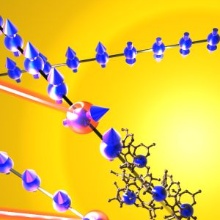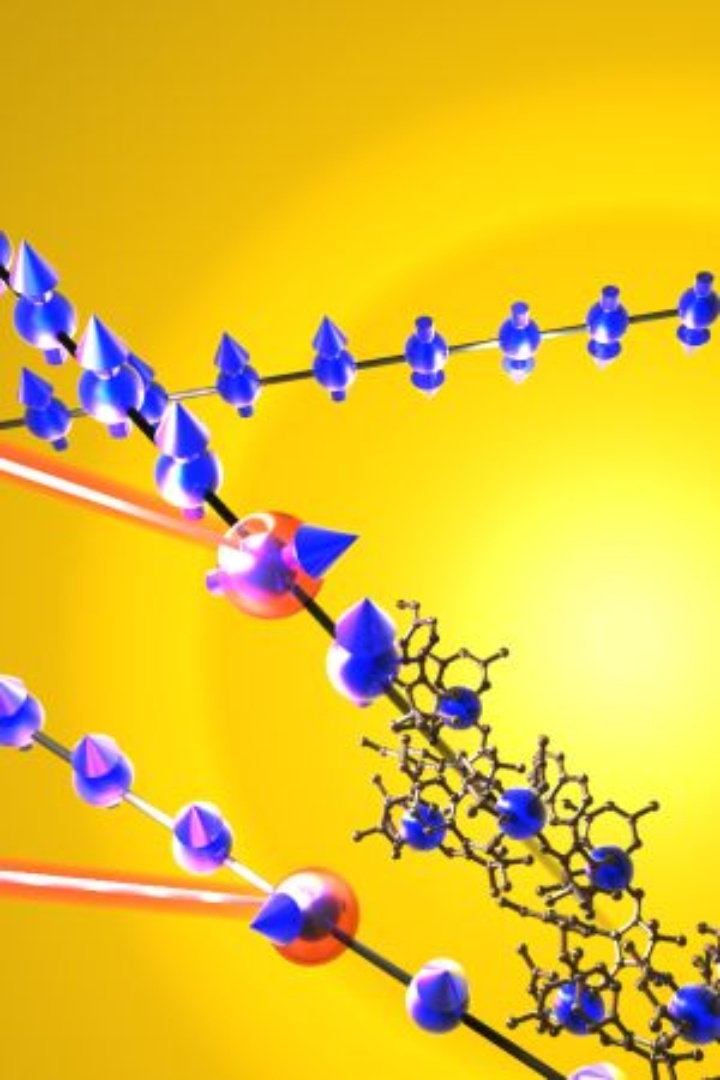Detaching a magnet from a refrigerator using a laser pointer initially seems pretty unrealistic. Yet a physicist team at the University of Stuttgart and Florence under the leadership of Sofja Kovalevskaja award winner Dr. Lapo Bogani has succeeded in performing precisely this feat. The scientists succeeded in optically influencing the features of minute nano-magnet chains with the help of lasers. Through this the molecules are demagnetised not coincidentally but their polarity can be reversed at the speed of lightning. The aim of the so-called kickoff mechanism is to promote the application of nano-magnetic chains, for example in cancer therapy or information technology and could even explain how a change of opinion simulated externally in social networks like Facebook can spread. The magazine Nature Materials reported on the research results in its 2nd December issue.*)
Nano-magnets are only the size of a millionth part of a millimetre and in contrast to
conventional magnets comprise only a few atoms, whose magnetism has a purely molecular origin. The
features of the minute atoms can be synthesised in a customised way, which theoretically makes them
interesting for a diverse range of applications. Therefore researchers worldwide are working at
full speed to find mechanisms which influence the magnetic features of the minute magnets from the
outside in a targeted way.
The international research team from Stuttgart and Florence pursued this question
theoretically and experimentally. The idea thereby is very simple: individual molecules are
stimulated in the ordered magnetic chain by means of laser light from little energy. This reduces
their interactions with their direct neighbours, which keep them magnetically oriented. This leads
to these molecules being able to reverse polarity more quickly and consequently the natural dynamic
demagnetisation process that is the coincidental orientation of the magnetic moments in the chains
is triggered more quickly. This results in the chains being able to be optically switched from
magnetic to non-magnetic under the effect of light. This makes the dream of scientists and
engineers to switch magnets on and off through light come true. The experiment by the physicists
from Stuttgart and Florence could be explained in such a way as if a magnet is illuminated with a
laser pointer, which is subsequently no longer magnetic.
The underlying model for this demagnetising process is well-known and is used in numerous
disciplines, which at first glance have little in common. The spectrum ranges from social network
dynamics to the spread of information in the nervous system up to chemical reaction processes. The
decisive question in all these disciplines is thereby how the development speeds of such processes
can be controlled from the outside through targeted stimulation. The “kick-off” mechanism,
so-called by the Stuttgart physicists, reduces the inertia of a system to external stimuli and
accelerates the development of the whole system. This is likely to stimulate research ideas in all
stated fields for new mechanisms to influence the temporal evolution of systems. The process could
possibly also be used to “trigger“ polymerisation processes or to contribute towards a better
understanding of the quick changes of opinion in social networks like Facebook. This also refers
here to chain reactions which can be simulated by the interactions of the users being numbered and
investigated in terms of how new information is able to spread from the outside. The answer to this
question remains to be seen, yet the starting signal for this has been given with the ”Kick-Off“
mechanism by the German-Italian research team.
Your contact persons:
Dr. Lapo Bogani, University of Stuttgart, 1. Physical Institute (Physikalisches Institut),
tel. 0711/685-64907, email: lapo.bogani (at) pi1.physik.uni-stuttgart.de
Andrea Mayer-Grenu, University of Stuttgart, Department University Communication, tel.
0711/685-82176, email: andrea.mayer-grenu (at) hkom.uni-stuttgart.de
*) Original publication:
Eric Heintze, Fadi El Hallak, Conrad Clauß, Angelo Rettori, Maria Gloria Pini, Federico
Totti, Martin Dressel and Lapo Bogani: “Dynamic control of magnetic nanowires by light-induced
domain-wall kickoffs”, Nature Materials DOI 10.1038/NMAT3498 or
http://www.nature.com/nmat/journal/vaop/ncurrent/full/nmat3498.html



